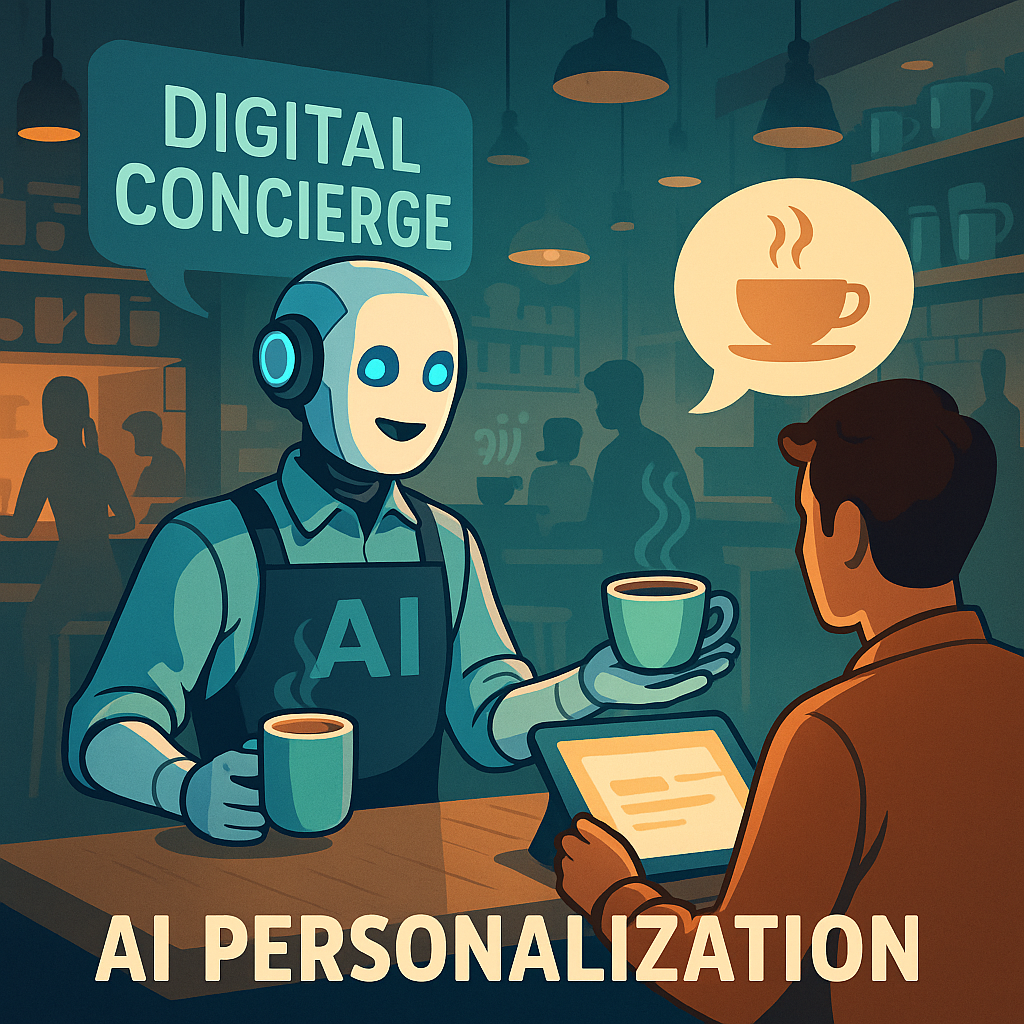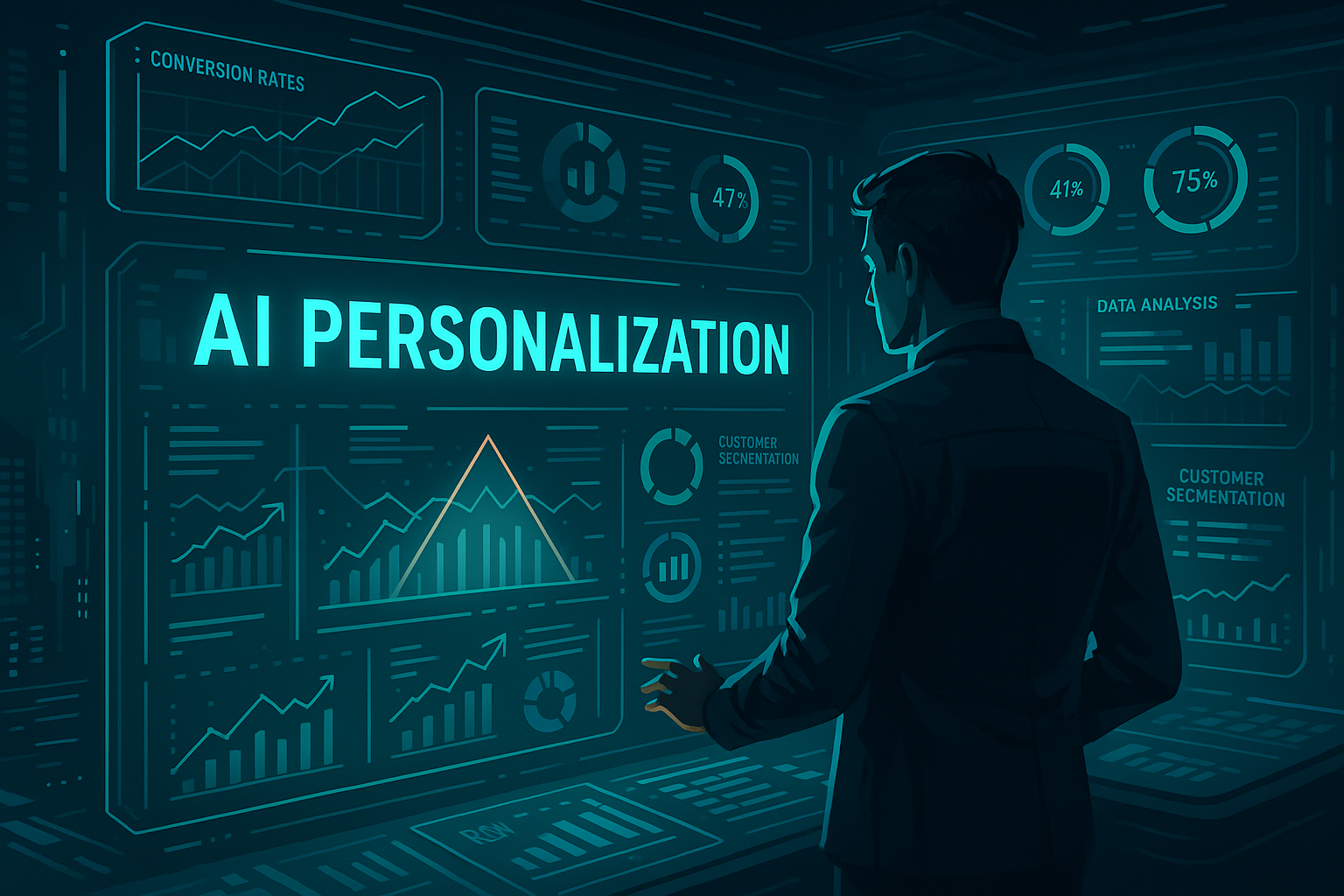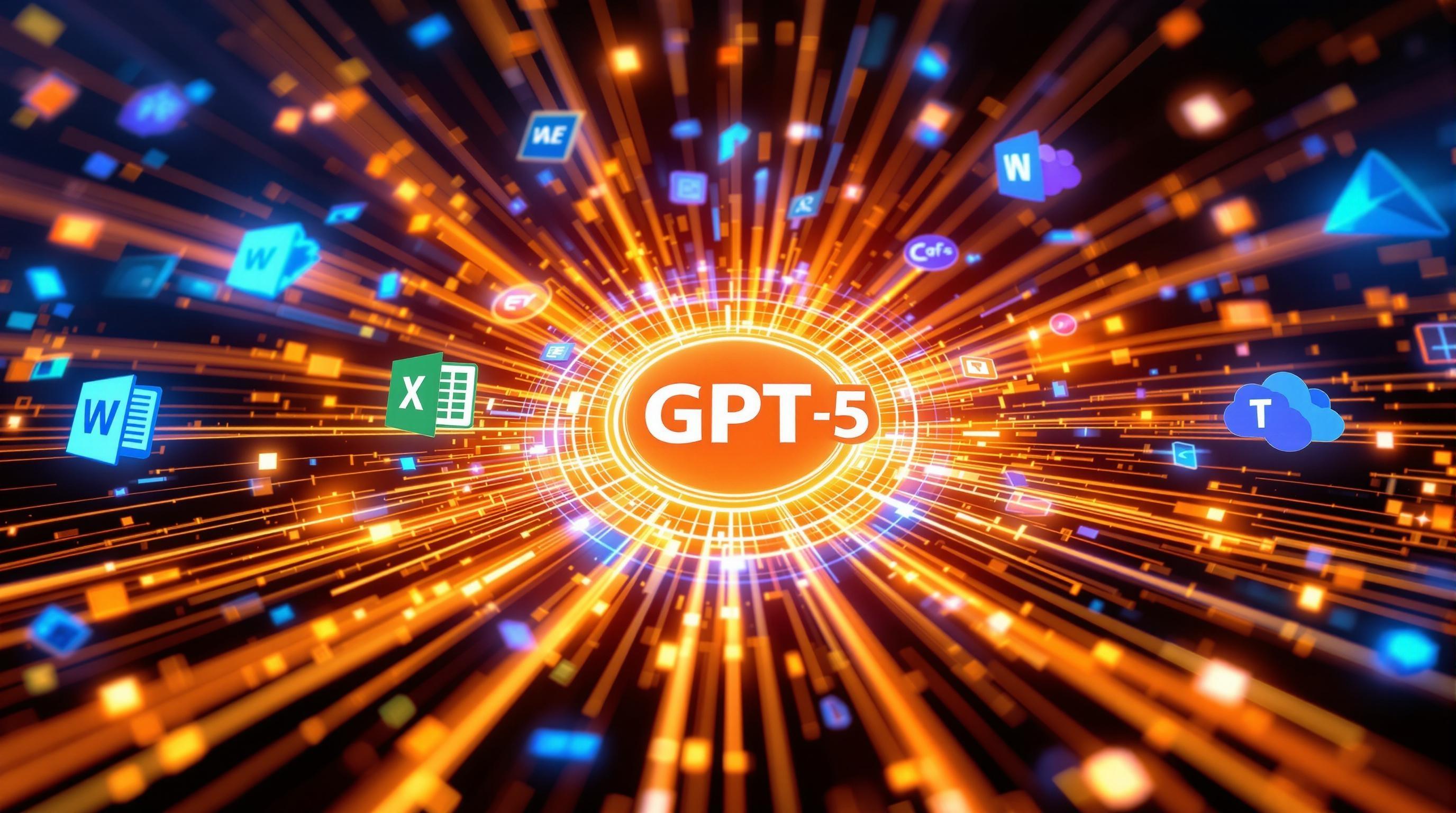AI-Powered Personalization: The Ultimate Marketing Guide for 2025

Why AI-Driven Personalization Is the Marketing Game-Changer You Need Today
Imagine a world where 80% of your potential customers are actively seeking brands that understand their unique needs and desires – this isn't a futuristic fantasy, but the reality of today's consumer landscape, where personalization reigns supreme. In 2025, AI-driven personalization isn't just a buzzword; it's the critical component that separates marketing successes from costly failures. It's the secret sauce that transforms generic campaigns into targeted experiences, boosting engagement, driving conversions, and fostering lasting customer loyalty. Think of it like this: traditional marketing is like casting a wide net, hoping to catch a few fish, while AI personalization is like using sonar to pinpoint the exact location of the biggest schools, ensuring a bountiful harvest. You could even use a tool like Hubspot Email Writer, which can help you create personalized emails at scale. Gone are the days of one-size-fits-all messaging and mass marketing blasts. Consumers are now savvy, demanding, and inundated with choices. They crave experiences tailored to their individual preferences, past behaviors, and real-time needs. Failing to deliver that level of personalization is akin to ignoring their existence, sending them straight into the arms of competitors who are willing to go the extra mile. AI-powered tools and techniques allow you to analyze vast datasets, predict customer behavior, and deliver hyper-personalized content at scale.
AI personalization has rapidly evolved from a 'nice to have' to an absolute necessity for businesses striving to thrive in the modern marketplace. It's no longer a competitive advantage; it's the bare minimum requirement for staying relevant. The brands that embrace AI to truly understand and cater to their customers' individual needs will be the ones that not only survive but flourish in the years to come. Those who cling to outdated, generic marketing approaches risk being left behind in the dust, their messages lost in the noise, their potential unrealized. Just as a tailored suit fits perfectly and feels infinitely better than an off-the-rack option, personalized marketing resonates far more deeply and drives significantly greater results. As we move forward, understanding the nuances of AI in marketing, perhaps through resources found under AI in Practice, will be key to staying ahead of the curve.

What Is AI-Driven Personalization?
Imagine a world where every marketing message feels like it was crafted just for you – that's the promise of AI-driven personalization. At its core, AI-driven personalization is the process of using artificial intelligence to deliver tailored experiences to individuals based on their unique characteristics, behaviors, and preferences. It's more than just using a customer's name in an email; it's about understanding their needs and anticipating their desires to create truly relevant interactions. These AI-powered strategies can be followed in combination with resources available in AI News.
But how does this digital sorcery actually work? AI personalization relies on sophisticated algorithms and machine learning models that analyze vast amounts of data from various sources. This data can include everything from browsing history and purchase patterns to social media activity and demographic information. By identifying patterns and correlations within this data, AI can predict individual customer preferences and tailor content, offers, and product recommendations accordingly. For example, an e-commerce site might use AI to suggest products similar to those a customer has previously purchased or viewed, or a streaming service might recommend movies or TV shows based on their viewing history. You might even leverage a tool like HubSpot, a comprehensive platform that uses AI to personalize marketing, sales, and customer service interactions.
To truly appreciate the power of AI-driven personalization, it's helpful to understand how it differs from more traditional, rule-based personalization. Rule-based personalization relies on predefined rules and segments to deliver targeted content. For example, a retailer might create a rule to offer a discount on winter coats to customers living in cold-weather regions. While this approach can be effective to some degree, it's limited by its reliance on static rules and its inability to adapt to individual customer nuances.
AI-powered dynamic personalization, on the other hand, takes a more sophisticated approach. Instead of relying on predefined rules, AI algorithms continuously learn and adapt based on real-time customer behavior. This allows for much more granular and personalized experiences. For instance, an AI-powered system might analyze a customer's browsing behavior on a website to identify their specific interests and then dynamically adjust the content and offers they see based on those interests. You might even use a tool like Google AI Studio, which allows developers to experiment with AI models and build personalized experiences into their applications. The difference in effectiveness can be substantial. Studies have shown that AI-powered personalization can lead to significant improvements in key metrics such as click-through rates, conversion rates, and customer satisfaction compared to rule-based approaches. The ability to deliver truly relevant and engaging experiences is what sets AI personalization apart and makes it such a valuable tool for modern marketers.
Key Benefits of AI Personalization for Marketers Today
Imagine a world where every customer interaction feels tailor-made, anticipating needs and exceeding expectations – that's the promise of AI personalization, and it's already transforming the marketing landscape. For marketers today, embracing AI-driven personalization isn't just a competitive advantage; it's becoming an absolute necessity to cut through the noise and connect with audiences on a deeper, more meaningful level. One of the most compelling benefits is the dramatic increase in engagement rates. Generic marketing blasts are easily ignored, but when content, offers, and experiences are precisely aligned with individual preferences, customers are far more likely to pay attention, click through, and actively participate. Think of it like this: instead of shouting into a crowded room, you're having a series of intimate, one-on-one conversations. AI algorithms analyze vast amounts of data to understand individual customer behaviors, preferences, and intent, allowing marketers to deliver hyper-relevant content at the right time and through the most effective channels. This leads to more meaningful interactions and strengthens the customer-brand relationship. Beyond simply capturing attention, AI personalization is a powerful engine for driving conversion rates and boosting ROI. By delivering the right message to the right person at the right time, marketers can significantly improve the likelihood of a purchase or other desired action. For example, an e-commerce site might use AI to recommend products based on a customer's browsing history, past purchases, and even real-time behavior on the site. These personalized recommendations can dramatically increase the chances of a sale, leading to a direct and measurable impact on the bottom line. Moreover, AI enables marketers to create truly scalable 1:1 customer journeys. In the past, personalized marketing was often a manual, time-consuming process, limiting its reach and impact. However, with AI, marketers can automate the personalization process at scale, delivering unique experiences to millions of customers without sacrificing quality or relevance. This means that every customer, regardless of their size or value, receives a personalized journey that is tailored to their individual needs and preferences. Finally, AI personalization unlocks a wealth of data-driven insights in real time. By continuously monitoring and analyzing customer interactions, marketers can gain a deeper understanding of what's working, what's not, and where to focus their efforts. This real-time feedback loop allows for continuous optimization, ensuring that marketing campaigns are always performing at their best. For example, a marketer might use AI to track the performance of different personalized email campaigns, identifying which messages are resonating with customers and which are not. These insights can then be used to refine future campaigns, improving engagement and driving even better results. To stay ahead of the curve, be sure to check out our AI News section to learn how AI tools are reshaping the landscape. Ultimately, the benefits of AI personalization extend far beyond simple marketing metrics; it's about building stronger, more meaningful relationships with customers, fostering loyalty, and driving sustainable growth. As AI technology continues to evolve, the opportunities for personalization will only continue to expand, making it an essential tool for marketers looking to thrive in the years to come.

Top AI Tools to Power Your Personalization Efforts
In the quest to hyper-personalize marketing campaigns, the right AI tools are your secret weapons, transforming generic outreach into tailored experiences that resonate deeply with each individual. Let's explore the top AI-driven platforms poised to redefine personalization across various marketing channels in 2025.
When it comes to content, relevance is paramount, and that's where AI-powered content recommendation engines shine. Tools like OneSpot use machine learning to analyze user behavior and content performance, delivering personalized content recommendations across websites, email, and social media. This ensures that every customer sees content tailored to their interests, increasing engagement and driving conversions. Similarly, Optimizely leverages AI to optimize content in real-time, dynamically adjusting headlines, images, and calls-to-action based on user data and A/B testing results. The benefit here is clear: by serving up the most relevant content at the right time, you drastically improve the customer journey and maximize the impact of your marketing efforts. For more insights into the broader AI landscape, be sure to check out our AI News section.
Email and messaging are prime real estate for personalization, and several AI tools are designed to help you make the most of these channels. Iterable is a growth marketing platform that uses AI to personalize email, push notifications, and in-app messages. It analyzes user data to predict the best time to send messages, personalize content, and automate marketing workflows. This means no more generic email blasts; instead, each customer receives a tailored message at the moment they're most likely to engage. Another powerhouse in this category is Klaviyo, which specializes in email marketing and automation for e-commerce businesses. Klaviyo uses AI to segment audiences, personalize email content, and optimize send times, resulting in higher open rates, click-through rates, and ultimately, more sales. These tools transform email marketing from a broadcast medium into a one-to-one conversation, fostering stronger customer relationships and driving revenue growth. You can also create personalized email writing using Hubspot Email Writer to create optimized emails.
Creating engaging on-site and in-app experiences is crucial for keeping customers coming back, and AI is revolutionizing how businesses approach this. Dynamic Yield (now part of Mastercard) uses AI to personalize website and app content, product recommendations, and offers in real-time. It analyzes user behavior, context, and preferences to deliver personalized experiences that drive engagement and conversions. Think of it as having a personal concierge for every website visitor, guiding them towards the products and content they're most likely to love. Bloomreach takes a similar approach, offering a comprehensive platform for personalizing the entire customer journey across all touchpoints. Its AI-powered capabilities include personalized search results, product recommendations, and content targeting, ensuring that every customer interaction is relevant and engaging. The beauty of these tools lies in their ability to create a seamless, personalized experience that keeps customers engaged and coming back for more. To further elevate your personalization strategy, consider exploring the principles of Prompt Engineering to craft compelling and relevant messaging.
By strategically leveraging these AI-powered personalization tools, marketers can move beyond generic campaigns and create truly tailored experiences that resonate with each individual customer. This not only drives engagement and conversions but also fosters stronger customer relationships and long-term loyalty. As AI continues to evolve, these tools will only become more sophisticated, offering even greater opportunities for personalization and marketing success. Remember to stay informed about the latest advancements by regularly visiting our Top 100 AI tools list.
Step-by-Step Implementation Guide for AI Personalization
Ready to stop imagining and start doing? Implementing AI personalization might seem daunting, but breaking it down into manageable steps makes the process far less intimidating and far more achievable. Let's walk through a practical, step-by-step guide to get you started.
First, you must audit your data sources. Think of your data as the fuel that powers your AI personalization engine. Before you even think about algorithms, you need to understand what data you have, where it lives, and how clean it is. Start by identifying all the sources of customer data within your organization: your CRM system, website analytics, email marketing platform like Mailchimp, social media insights, and even offline data like in-store purchase history. Next, evaluate the quality of each data source. Is the data complete and accurate? Are there any inconsistencies or gaps? Data cleaning and preprocessing are absolutely essential at this stage. You might need to deduplicate records, correct errors, and fill in missing values. Remember, garbage in, garbage out! Finally, ensure data privacy and compliance. With increasing regulations like GDPR and CCPA, it’s critical to handle customer data responsibly and ethically. Obtain necessary consents, anonymize data where appropriate, and implement robust security measures to protect sensitive information.
Next, choose the right AI platform. Selecting the appropriate AI platform is like choosing the right vehicle for a long journey; it will significantly impact your experience and destination. There's a vast and ever-growing ecosystem of AI tools and platforms available, each with its own strengths and weaknesses. Start by defining your specific needs and requirements. What personalization goals are you trying to achieve? What type of data do you have? What level of technical expertise do you have in-house? Consider factors like ease of use, scalability, integration capabilities, and pricing. For example, if you're focused on personalized email marketing, you might explore platforms that specialize in that area. If you need a more general-purpose AI platform, consider options like Google Cloud AI or Azure Machine Learning. Don't be afraid to experiment with different platforms and take advantage of free trials or demos. Some platforms also offer tools like Google AutoML, which simplifies machine learning for those with limited coding experience.
Now, you must define personalization rules and goals. This is where you translate your business objectives into concrete personalization strategies. Start by identifying the key customer segments you want to target. These segments could be based on demographics, purchase history, browsing behavior, or any other relevant criteria. For each segment, define specific personalization rules and goals. For example, you might want to show different product recommendations to new customers versus returning customers. Or, you might want to personalize the content of your website based on the visitor's location. Be as specific as possible when defining these rules. What actions do you want the AI to take? What outcomes are you hoping to achieve? Define clear, measurable goals for each personalization strategy. This will allow you to track your progress and measure the ROI of your efforts. Consider how tools for AI-powered SEO can complement your personalization efforts.
Run small-scale A/B tests to see how your personalization efforts perform. A/B testing is your reality check. Instead of rolling out a personalization strategy to your entire customer base, start with a small, representative sample. Divide your audience into two groups: a control group that receives the standard experience and a test group that receives the personalized experience. Then, carefully measure the results. Which group performed better? Did the personalized experience lead to higher conversion rates, increased engagement, or improved customer satisfaction? Use A/B testing to validate your assumptions and fine-tune your personalization strategies. For example, you might test different versions of a personalized email campaign to see which one generates the best results. Or, you might test different website layouts to see which one leads to higher click-through rates. There are various AI tools that can help facilitate A/B testing, ensuring statistical significance and faster iteration.
Finally, measure, iterate, and scale. Personalization is not a one-time project; it’s an ongoing process of continuous improvement. Once you’ve implemented your personalization strategies, it’s crucial to continuously measure their performance. Track key metrics like conversion rates, click-through rates, engagement levels, and customer satisfaction. Analyze the data to identify what’s working and what’s not. Be prepared to iterate on your strategies based on the data. If a particular personalization rule isn’t performing well, adjust it or try something new. As you gain confidence in your personalization strategies, gradually scale them to a larger audience. But don’t get complacent! Continue to monitor performance and iterate as needed. The AI landscape is constantly evolving, so it’s important to stay up-to-date on the latest trends and best practices. Keep an eye on resources such as AI News to adapt and stay ahead. By following this step-by-step guide, you can transform your marketing efforts and deliver truly personalized experiences that resonate with your customers. This ensures your AI efforts drive real results. Now, let's explore some real-world examples of successful AI personalization.

Common Pitfalls & How to Avoid Them
Diving headfirst into AI-powered personalization without a safety net can lead to some pretty spectacular faceplants, but knowing where the holes are in the ice is half the battle. Let's navigate the potential pitfalls and how to sidestep them, ensuring your AI personalization strategy is a resounding success rather than a cautionary tale.
One of the most tempting, yet dangerous, traps is over-automating without adequate human oversight. It's easy to get lured into believing that AI can handle everything, from content selection to customer interaction, but remember that AI is a tool, not a replacement for human judgment. Imagine an e-commerce site where AI-powered recommendations run wild, suggesting outrageously inappropriate items based on a misinterpreted data point. Or consider a chatbot, similar to ChatGPT, a powerful AI chatbot that can generate human-like text, that's left unchecked and starts spewing nonsensical or even offensive responses. The consequences can range from embarrassing gaffes to serious brand damage and customer churn. The solution? Implement a robust monitoring system. Regularly review AI-driven decisions, especially in customer-facing interactions. Establish clear guidelines and boundaries for AI actions, and always have a human in the loop to handle complex or sensitive situations. Think of it as a pilot and autopilot system; the AI handles the routine, but a human is always ready to take the controls when needed.
Another critical area is ignoring privacy and compliance regulations, such as GDPR (General Data Protection Regulation) or the DSVGO (Datenschutz-Grundverordnung), the German implementation of GDPR. AI personalization thrives on data, but that data comes with responsibilities. Failing to handle customer data ethically and legally can lead to hefty fines, legal battles, and irreparable damage to your reputation. Picture a scenario where your AI-powered marketing campaign uses customer data to create highly personalized ads without obtaining proper consent. Or perhaps your AI system inadvertently leaks sensitive customer information due to inadequate security measures. These are not just hypothetical risks; they are real threats with serious consequences. The key is to build privacy and compliance into the very foundation of your AI personalization strategy. Implement transparent data collection practices, obtain explicit consent for data usage, and ensure your AI systems comply with all relevant regulations. Tools like DeepPrivacy can help anonymize data for maintaining compliance with GDPR when training models. Regularly audit your AI systems to identify and address potential privacy vulnerabilities. Think of data privacy as the bedrock of trust – without it, your entire personalization edifice could crumble.
Finally, never neglect ongoing model training. AI models are not static; they need constant feeding and nurturing to stay relevant and effective. Imagine an AI-powered recommendation engine that's trained on outdated data and continues to suggest products that are no longer in demand. Or an AI marketing tool that uses stale customer profiles to send irrelevant or even annoying messages. The result is a diminished return on investment, a frustrated customer base, and a growing sense that your personalization efforts are missing the mark. The antidote is continuous learning. Regularly update your AI models with fresh data, monitor their performance metrics, and retrain them as needed. Experiment with different algorithms and features to optimize their accuracy and effectiveness. Think of your AI models as living organisms that require constant care and attention to thrive. Regularly checking AI News can help your team stay up to date on best practices and emerging technologies.
By proactively addressing these common pitfalls, you can pave the way for a successful and sustainable AI personalization strategy that delivers real value to your business and your customers.
Conclusion: Embrace AI Personalization for Marketing Success
In conclusion, AI-powered personalization isn't just a fleeting trend; it's the cornerstone of future marketing success, offering unparalleled opportunities to connect with your audience on a deeper, more meaningful level, driving engagement and ultimately, conversions. By harnessing the power of AI, marketers can move beyond generic campaigns and craft tailored experiences that resonate with each individual customer, fostering loyalty and advocacy. Now, we'd love to hear from you: what's your biggest challenge when it comes to implementing personalization in your marketing strategy? Share your thoughts and questions in the comments below – let's learn and grow together. To help you get started, we're offering a downloadable checklist of key strategies and best practices for implementing AI-driven personalization, plus a link to a demo of HubSpot, an AI powered platform that enables businesses to deliver exceptional customer experiences. The time to act is now. Don't let your competitors gain an edge with AI personalization. Embrace the transformative power of AI, start experimenting, and unlock a new era of marketing success.
Keywords: AI personalization, AI-driven marketing, personalized marketing, artificial intelligence in marketing, customer experience personalization, marketing personalization, AI marketing tools, dynamic personalization, scalable personalization, data-driven insights, personalized customer journeys, AI content recommendation, email personalization, on-site personalization
Hashtags: #AIPersonalization #MarketingAI #PersonalizedMarketing #AIinMarketing #CustomerExperience
For more AI insights and tool reviews, visit our website https://best-ai-tools.org, and follow us on our social media channels!
Website: https://best-ai-tools.org
X (Twitter): https://x.com/bitautor36935
Instagram: https://www.instagram.com/bestaitoolsorg
Telegram: https://t.me/BestAIToolsCommunity
Medium: https://medium.com/@bitautor.de
Spotify: https://creators.spotify.com/pod/profile/bestaitools
Facebook: https://www.facebook.com/profile.php?id=61577063078524
YouTube: https://www.youtube.com/@BitAutor
Recommended AI tools
ChatGPT
Conversational AI
AI research, productivity, and conversation—smarter thinking, deeper insights.
Sora
Video Generation
Create stunning, realistic videos and audio from text, images, or video—remix and collaborate with Sora, OpenAI’s advanced generative video app.
Google Gemini
Conversational AI
Your everyday Google AI assistant for creativity, research, and productivity
Freepik AI Image Generator
Image Generation
Generate on-brand AI images from text, sketches, or photos—fast, realistic, and ready for commercial use.
Adobe Photoshop
Image Generation
Create, edit, and design with industry-leading AI-powered image innovation.
n8n
Productivity & Collaboration
Open-source workflow automation with native AI integration


